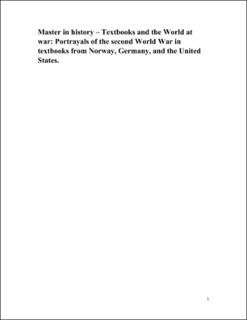| dc.description.abstract | The second World War looms large in the collective consciousness of the world. Its impact is the subject of countless investigations, its origins and events some of the most popular history topics among those who normally don’t give the subject a second glance. Its place in our education is just as fascinating as the war itself, as it is in how we teach about the war that we can most clearly see how a nation understands the war. While textbooks are far from the only thing of importance in a classroom, they are still the best avenue for beginning to investigate the topic of how we depict the second World War in our schools. The importance and impact of textbooks on classroom education is universally acknowledged, and they act as a state endorsed version of the story.
Throughout this text I have looked into how a nation like the United States might feel a level of distance from the war, where the importance of the war comes not from what happened in it, but of what it led to. I examine how to a nation like Germany the war is much closer to home. An event of immense, perhaps unmatched, importance, that must be taken apart an examined piece by piece, that we may better understand how it came to be, and how we today do our best to avoid ever repeating it. I discuss how a nation like Norway might be in the process of revising their understanding of the period, changing an interpretation that has lasted for a century as new eyes look upon the source material, and conclude that old interpretations simply are not adequate. The different roles played by Adolf Hitler in each of the three nations, as the author of destruction, head of a vast movement accidentally unleashed, and as the enemy of all, including his own home, acting from the background, is another topic this text is occupied by. Lastly, the text is interested in those that do not feature in the story, a story that seemingly central actors like Italy play no part in, and which is best described as two separate wars taking place at the same time, the wars of Hitler versus Britain and the Soviets, and the Japan versus the United States.
It is a common interpretation that history looks different to everyone, and it a core part of our education is supposed to be how different people might see the same event differently. This text is one attempt at examining just how different our interpretations really are. | |
